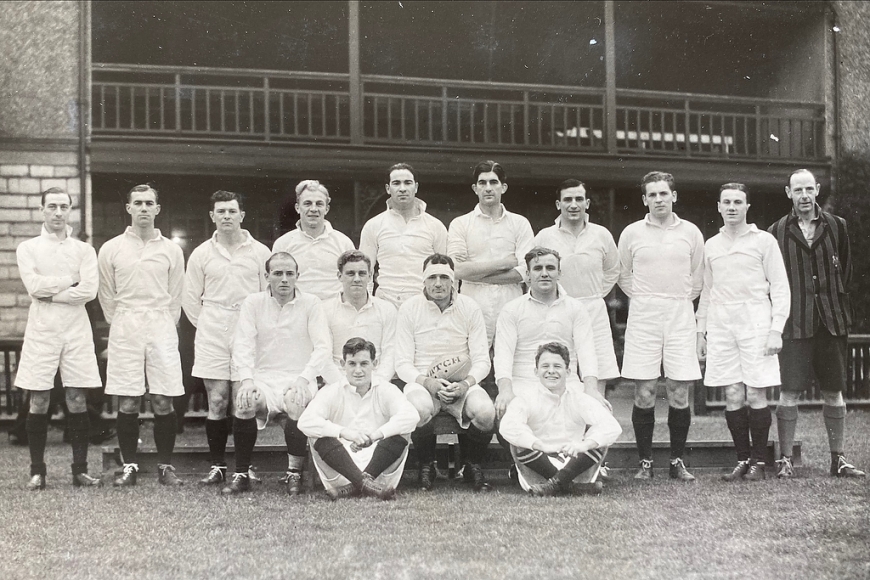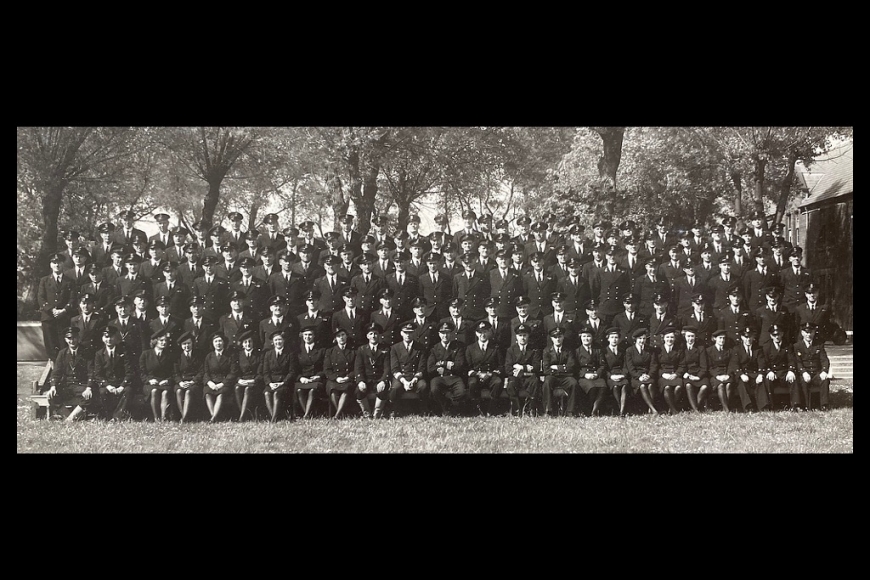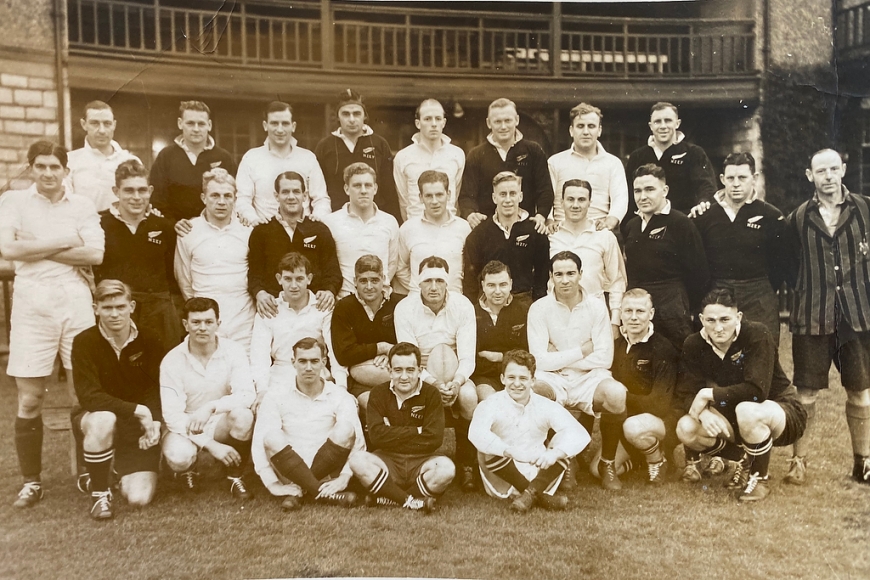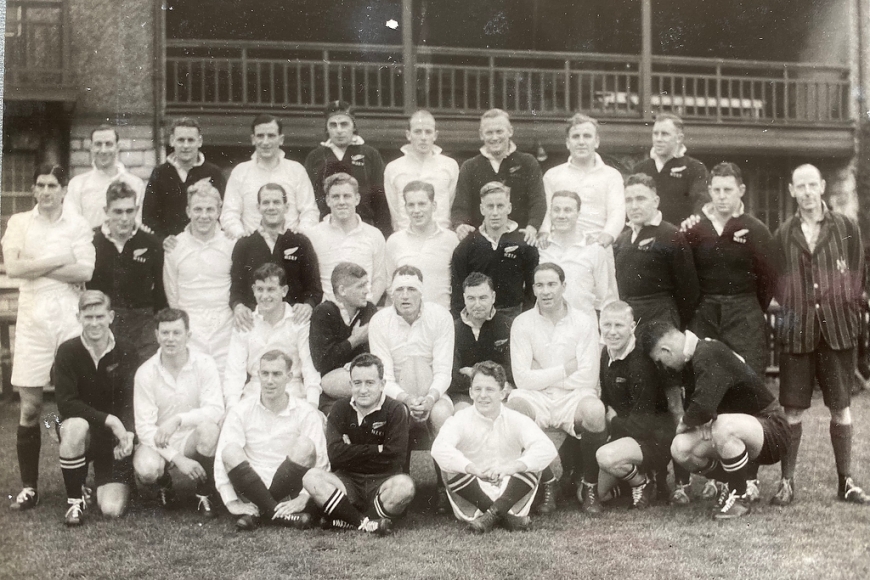Khaki All Blacks Honoured by Capped Match; Rugby Resumes after VE Day
How do you celebrate Victory in Europe? If you are the 2nd New Zealand Expeditionary Force you embark on a 33 match tour of the United Kingdom, Ireland, France and Germany. You win 29 of your matches only losing 2. If you are the Royal Navy Rugby Union, you honour their ambition by making the game a ‘capped’ match ensuring its unique place in Navy Rugby history.
On Tuesday 8 May 1945 Nazi Germany’s unconditional surrender of its armed forces was accepted by the Allied Forces. 5 years and 3 months earlier the first troops from New Zealand’s 2nd Expeditionary Force had landed in Egypt. They had seen action with the Desert Rats as part of the North Africa campaign before crossing into Italy and fighting northwards along the Adriatic coast. Their journey home was to be a long one as they first embarked on a mammoth rugby tour which had three specific aims:
- To revive rugby interest in the British Isles
- To aid Army, Navy, Air Force and New Zealand War Charities
- To play bright open football with winning the game the least important factor
Wherever they played the team were welcomed by large crowds and they raised over £40,000 for the relevant charities. In December they played all three Service sides on consecutive weeks finishing with the match against the Royal Navy, held at Burnaby Road Portsmouth.
The Royal Navy Rugby Union Committee, only recently reformed after the war, made the decision that the match should be a capped game and therefore until 2011when caps were awarded, for matches against Marine Nationale, the game had a unique status as the only match not against the Army or Royal Air Force to be granted capped status. The Navy team, that day, played in white with white shorts but retained their navy blue stockings, although as with the Inter Service matches in 1946 the socks did not have the famous 3 white stripes which were part of the Union’s byelaws until removed as kits became more commercial in design.
Of the three Service sides, the New Zealand Army faced the British Army first, at a match played at Bristol’s Memorial Ground in front of 15,000 spectators. The British side enjoyed much of the possession and territory in the first half and for many looked as if they would win the game. The British Army's try, for Ward, started in their own 22, was probably the best score of the match. With the conversion landed the British Army enjoyed a 5-0 lead but the New Zealand side levelled just before half time with a try from Smith, under the posts, easily converted by Scott. The second half though belonged to New Zealand, aided by the British Army losing their centre Ward (no replacements in those days) and having to play with 14 men. Four second half tries, two through Argus followed by a try from Young and then a third for Argus, all converted by Scott wrapped up the game for the touring side.
The New Zealanders played the Royal Air Force a week after the Army, the game hosted at Leicester's Welford Road ground. For seventy five minutes of the game the sides appeared equal with the defences holding the advantage on a bitterly cold day in the East Midlands. However, in the five minutes before the half time break the New Zealand's opened the scoring when Arnold fed Argus from a 5m scrum, who crossed for the try. From the restart the RAF pressed hard for the swift reply but were thwarted by a strong counter attack from Smith who raced up field. The New Zealand forwards kept the ball alive and Finlay crossed for the second try followed quickly by a New Zealand third, this time for their powerful backrow forward, Arnold. Having missed the two earlier conversion attempts, Cook landed his 3rd kick for goal and as the half time whistle sounded the New Zealand Army left the pitch with a 11-0 lead, a lead that was to remain unaltered in the second half. As an aside to this match there are reports of a New Zealand Services team playing a Commandos XV, also at Leicester, prior to the start of the tour. It is not known whether the New Zealand team referred to was the 2nd Expeditionary Force or another side of New Zealand servicemen enjoying rugby before they returned home.
And so to Portsmouth. The Navy side that took the field at Portsmouth was captained by Wally Hammond. He had been stationed at Whale Island for the last year of the war and being a keen and talented sportsman in a number of sports was quick out of the blocks to represent the Royal Navy as hostilities ceased. Prior to playing the first games of the new rugby season, as skipper of United Services, he had kept wicket as the Royal Navy despatched the Army at Lords. Hammond took 4 colleagues with him from the United Services side into the full Navy team and though they could not match the team cohesion of the Khaki Kiwis, the Navy team did produce a remarkable performance and impressed the watching national press.
As one paper reported:
“Best Navy XV for Years. Tough side that tested the Kiwis.”
The detailed match report was as follows:
“Irrespective of the result it was apparent that this was the best Navy side seen for a long time, and the fact they did so well against their famous opponents at Portsmouth in the first game together speaks volumes. Cdr Hammond, at the age of 36, was one of the best forwards on the field and his experience was a great strength to the men under his command. Constance was an elusive runner at flyhalf but the Navy three-quarters were usually held up as a line by their opponents crowding tactics. Healy gave a polished display at fullback. The Kiwis were most dangerous after they had pounced on their opponents’ mistakes, and Dobson was always a source of trouble in this respect. Scott did well at fullback and, as was to be expected the Kiwis’ teamwork was superior but in toughness and fitness they met their match in the Navy.”
It was the Navy who were to take the lead through a try by Williams. However, this was soon cancelled out through a penalty kick from Scott. Early in the second half, a second Scott penalty kick gave the New Zealanders a 6-3 lead. Despite coming under intense Navy pressure, the away side were able to hold on to this lead for the rest of the match. The Kiwis were using a version of today’s rush defence which crowded the Navy’s back line, a problem that they, along with most other sides who played the New Zealanders, were unable to counter.
The tour was a huge success and provided a much needed impetus to the domestic game after the initial euphoria of the VE Day celebrations had died down. However, it was not quite the end of the story. Fifty years after the great tour the New Zealand Army once more toured the UK to celebrate their forbears. New Zealand rugby has always had a great understanding of the importance of their history and where each generation sits within this. It remains a key part of their performance model and in the modern sporting world also a key part of the All Blacks commercial model. The 1995 tour involved 6 matches including a game against the British Army and also a game against the Royal Navy in Devonport which they won 15-6. As part of that tour they were accompanied by 12 members of the original touring "Kiwis”, including Bob Scott (by then a retired All Black with 17 caps) whose kicking undid Hammond’s side all those years earlier.
Celebrations for the 75th Anniversary of the Victory in Europe are naturally subdued due to restrictions caused by the Covid-19 pandemic but the sacrifice of so many members of the Allied Forces do need to be remembered and their victory in Europe celebrated. But we should also celebrate the great rugby generosity and achievement of the New Zealand Army who did so much, as they played rugby throughout Europe, before returning home. The Union in 1945 honoured them then with affording the match cap status, a fitting acknowledgement of a special team who retain a unique place in the history of the Royal Navy Rugby Union.
Complete Results for Tour:
7 Oct 1945 Swansea v New Zealand Army - NZEF Win 22-6
30 Oct 1945 Llanelli v New Zealand Army - NZEF Win 18-8
03 Nov 1945 Neath v New Zealand Army - NZEF Win 22 - 15
10 Nov 1945 Northern Services v New Zealand Army - NZEF Win 14-7
14 Nov 1945 Ulster v New Zealand Army - NZEF Win 10-9
17 Nov 1945 Leinster v New Zealand Army - Draw 10-10
24 Nov 1945 England v New Zealand Army - NZEF Win 18-3
01 Dec 1945 British Army v New Zealand Army - NZEF Win 25-5
08 Dec 1945 RAF v New Zealand Army - NZEF Win 11-0
15 Dec 1945 Royal Navy v New Zealand Army - NZEF Win 6-3
22 Dec 1945 London Clubs v New Zealand Army - NZEF Win 30-0
26 Dec 1945 Cardiff v New Zealand Army - NZEF Win 3-0
29 Dec 1945 Newport v New Zealand Army - Draw 3-3
05 Jan 1946 Wales v New Zealand Army - NZEF Win 11-3
12 Jan 1946 Combined Services v New Zealand Army - NZEF Win 31-0
19 Jan 1946 Scotland v New Zealand Army - NZEF Loss 11-6
24 Jan 1946 Scottish Universities v New Zealand Army - NZEF Win 57-3
26 Jan 1946 North Midlands v New Zealand Army - NZEF Win 24-9
31 Jan 1946 East Midlands v New Zealand Army - NZEF Win 14-0
02 Feb 1946 Northern Counties v New Zealand Army - NZEF Win 25-8
09 Feb 1946 Lancs, Cheshire & Yorks v New Zealand Army - NZEF Win 41-0
14 Feb 1946 Oxford University v New Zealand Army - NZEF Win 31-9
16 Feb 1946 Devon & Conrwall v New Zealand Army - NZEF Win 11-3
20 Feb 1946 Cambrisge University v New Zealand Army - NZEF Win 15-7
23 Feb 1946 Gloucs & Somerset v New Zealand Army - NZEF Win 11-0
27 Feb 1946 Monmouthshire v New Zealand Army - NZEF Loss 0-15
02 Mar 1946 Aberavon v New Zealand Army - NZEF Win 17-4
10 Mar 1946 France v New Zealand Army - NZEF Win 14-9
13 Mar 1946 BAOR v New Zealand Army - NZEF Win 12-0
16 Mar 1946 Combined Services v New Zealand Army - NZEF Win 20-3
24 Mar 1946 France v New Zealand Army - NZEF Win 13-10
27 Mar 1946 France A v New Zealand Army - NZEF Win 38-9
31 Mar 1946 Ile De France v New Zealand Army - NZEF Win 24-13
By line: Geraint Ashton Jones
Images: Alligin Photography / Hammond Family










